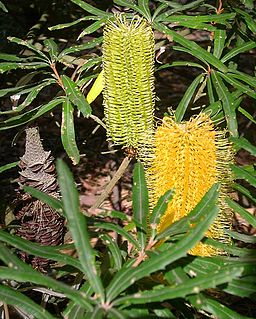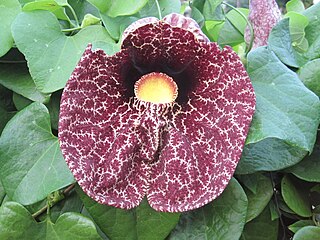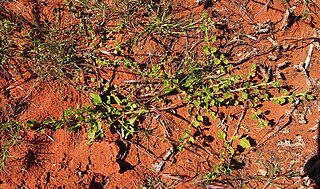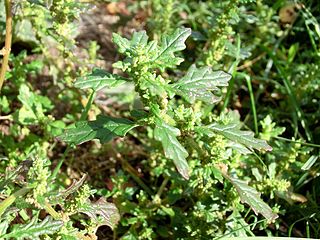
Dysphania ambrosioides, formerly Chenopodium ambrosioides, known as Jesuit's tea, Mexican-tea, payqu(paico), epazote, mastruz, or herba sanctæ Mariæ, is an annual or short-lived perennial herb native to Central America, South America, and southern Mexico.

Dysphania botrys, the Jerusalem oak goosefoot, sticky goosefoot or feathered geranium, is a flowering plant in the genus Dysphania. It is native to the Mediterranean region.

Banksia littoralis, commonly known as the swamp banksia, swamp oak, river banksia or seaside banksia and the western swamp banksia, is a species of tree that is endemic to the south-west of Western Australia. The Noongar peoples know the plant as pungura, boongura or gwangia. It has rough, crumbly bark, linear, more or less serrated leaves arranged in whorls, yellow flowers and up to two hundred follicles in each head.

Banksia seminuda, commonly known as the river banksia, is a tree in the plant genus Banksia. It is found in south west Western Australia from Dwellingup (32°42′ S) to the Broke Inlet east of Denmark (34°57′ S). It is often mistaken for, and was originally considered a subspecies of, the Banksia littoralis. Stephen Hopper described the subspecies remanens as a short-leaved shrubby form found in the coastal sands below granite outcrops in the Walpole-Nornalup National Park, however George does not feel this form warrants taxonomic recognition as it lies within the normal variability of the species and there was no clear distinction between it and the other populations of B. seminuda.

Aristolochia littoralis, the calico flower or elegant Dutchman's pipe, is a species of evergreen vine belonging to the family Aristolochiaceae.

Alex George's taxonomic arrangement of Banksia was the first modern-day arrangement for that genus. First published in 1981 in the classic monograph The genus Banksia L.f. (Proteaceae), it superseded the arrangement of George Bentham, which had stood for over a hundred years. It was overturned in 1996 by Kevin Thiele and Pauline Ladiges, but restored by George in 1999. A recent publication by Austin Mast and Kevin Thiele suggests that it will soon be overturned again.

Heritiera littoralis, the looking-glass mangrove is a large tree with wing shaped nuts, which is most easily recognised by the silvery scales on the underside of its leaves, which therefore appear green from top and white from below, although Litsea mellifera A.C. Smith, has the same type of leaves. The tree is usually found to grow along the seashore in Bangladesh & Indian Subcontinent, Southeast Asia and Tropical Africa.

Medicago littoralis is a plant species of the genus Medicago. It is found primarily in the Mediterranean basin. It forms a symbiotic relationship with the bacterium Sinorhizobium meliloti, which is capable of nitrogen fixation. Common names include shore medick, water medick, coastal medick, and strand medick.

Spodoptera littoralis, also referred to as the African cotton leafworm or Egyptian cotton leafworm or Mediterranean brocade, is a species of moth in the family Noctuidae. S. littoralis is found widely in Africa, Mediterranean Europe and Middle Eastern countries. It is a highly polyphagous organism that is a pest of many cultivated plants and crops. As a result, this species was assigned the label of A2 quarantine pest by the EPPO and was cautioned as a highly invasive species in the United States. The devastating impacts caused by these pests have led to the development of both biological and chemical control methods. This moth is often confused with Spodoptera litura.

Dysphania melanocarpa, commonly known as black crumbweed, is an annual herb that grows in arid and semi-arid regions of Australia.

Dysphania multifida is a species of flowering plant in the family Amaranthaceae known by the common names cutleaf goosefoot and scented gooosefoot.

Dysphania pumilio is a species of flowering plant in the family Amaranthaceae known by the common name clammy goosefoot.

Allocasuarina littoralis, commonly known as black sheoak, black she-oak, or river black-oak, is an endemic medium-sized Australian tree. A. littoralis is named for its growth near the coast; this is somewhat misleading, as it will grow well both inland and in coastal zones.

Dysphania is a genus of colourful moths in the family Geometridae and typical of the tribe Dysphaniini; they are sometimes called 'false tiger moths' and are found in northeast Australia, Melanesia, and south, east and southeast Asia.

Dysphania militaris is a species of moth of the family Geometridae that is found from in the tropical regions of South and Southeast Asian countries such as China, India, Myanmar, Andaman Islands, Sumatra and Java. It was first described by Carl Linnaeus in his 1758 10th edition of Systema Naturae.

Dysphania is a plant genus in the family Amaranthaceae, distributed worldwide from the tropics and subtropics to warm-temperate regions.

Biliatresone is an example of a very rare type of a naturally occurring isoflavonoid-related 1,2-diaryl-2-propenone found in Dysphania glomulifera and D. littoralis. It has been found to cause extrahepatic biliary atresia in a zebrafish model. The enone moiety of biliatresone is particularly reactive, being enhanced by the methylenedioxy, methoxy and hydroxy groups, and undergoes ready Michael addition of water and methanol.

Carallia brachiata is a large tree in the family Rhizophoraceae, that grows to a height of 25 metres and found from Australia, Malesia, Indochina through to the Western Ghats. It is the host plant of the moth Dysphania percota in India and Dysphania numana in Australia.

Dysphania pusilla, formerly Chenopodium pusillum, otherwise known as pygmy goosefoot or parahia in Māori, is a prostrate herb endemic to the north-eastern parts of South Island, New Zealand. Presumed extinct after 56 years without recorded observations, the species was rediscovered in 2015.

















